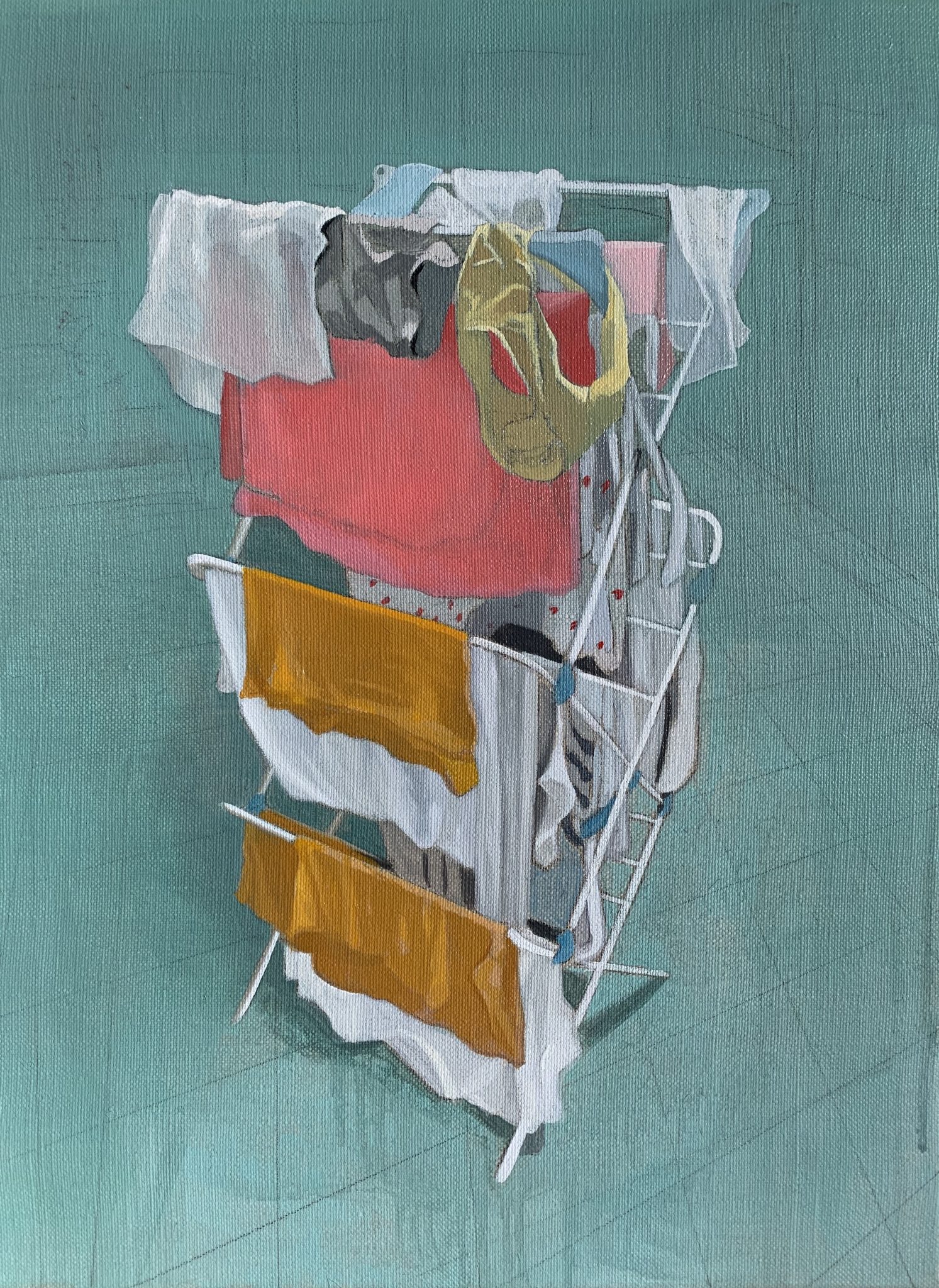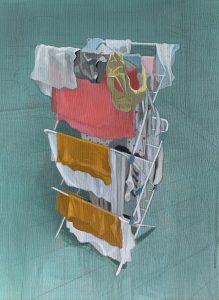Fergus Hare makes oil paintings of the Sussex landscape. However, rather than paint directly from the landscape, these works stem from the imagination. With a firm nod to the fantastical “valley of vision” of Samuel Palmer and the mysticism of William Blake, Hare re-imagines the landscape as a dream-scape, on the edge of twilight. Alongside his paintings Hare also makes extraordinary charcoal drawings of the moon and planets. A solar system of the imagination.
In his landscape painting Fergus Hare gives us constants that we perhaps associate instinctively with this genre: trees, hills, a glimpse of the sea, often the moon, but most of all skies. Cloud-filled, busy, moving, ever changing skyscapes that cast a mood on the landscape below. It may help to understand and appreciate the effect of his work even more knowing how he works. He paints mostly outdoors, en plein air, sketching what he sees, with some manipulation of what appears in the finished painting. Figures are rare, as he does not want to give the impression of staging them like ornaments in the composition, but if they appear during a painting session then they may well become part of the work. He believes in the importance of observation and resists working from photographs. As much work as possible is carried out in the open, with some finishing touches applied later in the studio, in order to retain the immediacy of the initial sketch. Motifs and locations seem to come to him; he does not go out in search for the perfect spot but paints instinctively what he encounters, without an apparent emotional attachment to a particular area. It is very tempting to compare him, on the grounds of subject matter, style and working methods, to the great masters of British landscape painting. The most obvious point of reference is perhaps John Constable, especially as Fergus’s small format oils bear a sometimes uncanny resemblance to Constable’s oil sketches. He admits that the Romantic period has always been his favourite and he has been greatly inspired and informed by Constable, Joseph Wright of Derby and Thomas Gainsborough. However, he also makes that point that, ‘I never wanted to copy the great painters from that period, but I wanted to be as good as them. That’s what we should aspire to, being as good as we can be.’
Fergus’s palette is limited, comprising a handful of colours only, created from a few select pigments: Payne’s Grey, Brown-Black, Burnt Umber, Burnt Sienna, Prussian Blue, Yellow Ochre, Cadmium Red, Olive Green, Naples Yellow, Titanium White and flesh tints. There is a deliberate and measured minimalism to his work that makes us look again and again at the same deceptively simple composition. At first glance we may see an identifiably English or Irish landscape and could be forgiven for attributing the vague term ‘timeless’ to it. We might even think of it as an image of the past, as Fergus uses the same basic iconography as the great British landscape painters of the late 18th and early 19th century, depicting a pre-industrial idyll of unspoilt lush nature. But look closer and it becomes clear that his landscapes are very much of this century, with subtle but unmistakable references to the time of their creation. The odd telegraph mast, a hint of contemporary architecture, the absence of anachronistic picturesque elements such as carts or old farming equipment.
In a key work, We Live, We Die, Fergus links past, present and future, by placing a space shuttle, an object that epitomises technological advances and is a symbol of the possibility of other life forms, other worlds, into a Romantic context of cloud formations and more than a hint of the Sublime. He rightly states that surely, given the interest that many Romantic painters had in meteorology and astronomy, they would have embraced the notion and visual richness of space travel. To Fergus, the inclusion of the shuttle makes perfect sense, as it is enfolded in what he is passionate about: clouds. Although he considers him further removed from Turner than other artists of that period, We Live, We Die has perhaps the significance for Fergus that the steam train had for Turner in Rain, Steam and Speed (1844). This ambitious canvas may also mark a new and more experimental phase of his career. Unlike most of his other work, We Live, We Die is based on a photograph from a photo essay on the last days of shuttle programme for the National Geographic.
Fergus Hare can without a doubt be seen in a tradition of Great British landscape painting, bringing the genre into the 21st century while referencing and drawing inspiration from the past and future. He meticulously observes each chosen location, but looks at it with an artist’s eyes, taking some elements away, simplifying others. The narrative and visual power of his work lies in the depiction of natural light, atmospheric conditions and cloud formations. There is a language in the sky, and Fergus paints it, giving us the essence of landscape.
Alexandra Loske 2015
Dr Alexandra Loske is an art historian with a particular interest in late 18th and early 19th century European art and architecture. She works as a curator at the Royal Pavilion & Brighton Museums and teaches Art History at the University of Sussex. She frequently includes Fergus’s work in lectures about British landscape painting.
FERGUS HARE
SELECTED EDUCATION, EXHIBITION & AWARD HISTORY
1996
BTECH Foundation, Camberwell College of Arts
1999
BA Illustration, Norwich School of Art & Design
Noel Spencer Annual Illustration Award
Winsor & Newton Young Artist of The Year in watercolour, Mall Galleries
2001-2012
Antonia Fraser Gallery, London - Group shows
2006
The Laura Bartlett Gallery, London - ‘The Observatory Volume 1 – Group show
Benenden School, Kent - Solo show
2011
Brighton Art Fair
St. Anne’s Galleries, Lewes –‘Little Wonder’ - Group show
2012
Brighton Pavilion The Open House Group show
Brighton Art Fair
St. Anne’s Galleries, Lewes - Summer Exhibition - Group show & Little Wonder Group show
2013
Pelham House, Lewes 'The Horizon Rim' - Solo show
Brighton Art Fair
54 The Gallery, Shepherd’s Market, London Group show
St. Anne’s Galleries, Lewes - Artwave - Group show & Little Wonder - Group show
Benenden School, Kent - Solo show
Sussex and The Georgian Age: Turner, Constable & the Picturesque Landscape
Medici Gallery, London Winter Exhibition Group show
2014
Medici Gallery, London - Spring Exhibition
Highgate Contemporary Art, London ‘Land, Sea and Sky’ Group show
Medici gallery, London Summer Exhibition
Mascall’s Gallery, Kent Discovering Palmer’s Kent; Samuel Palmer, Graham Sutherland and Paul Drury
St. Anne’s Galleries, Lewes - Artwave

